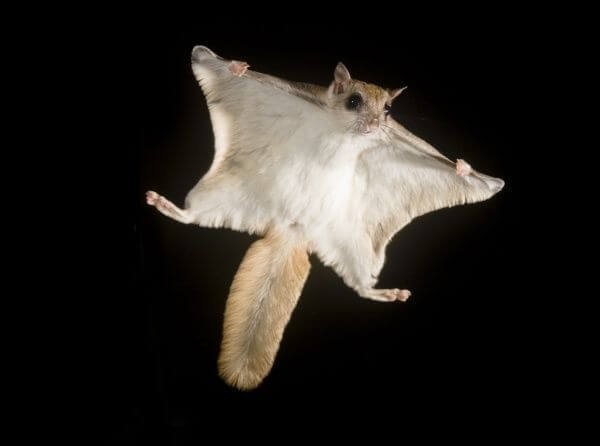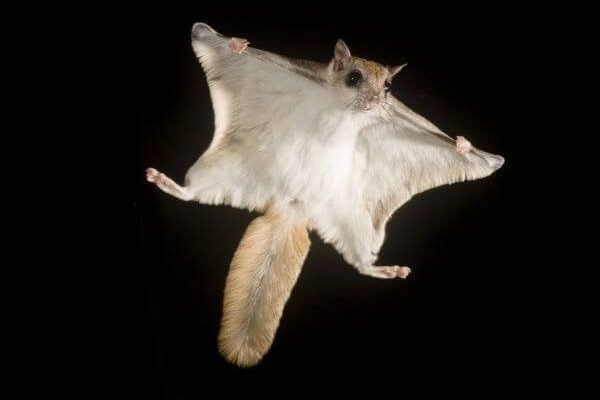
Imagine you’re at a wildlife park, surrounded by a mix of furry friends. Some glider species are masters of aerial acrobatics, while others might surprise you with their unique adaptations. In this article, we’ll explore 10 animals similar to the flying squirrel, diving into what makes each one distinct. By the end, you’ll not only know how to spot these creatures but also what sets them apart.
1. Sugar Gliders
If you’re a fan of flying squirrels, you’ll absolutely adore sugar gliders! These tiny marsupials are native to Australia and New Guinea. Like flying squirrels, sugar gliders have a patagium, which is a membrane that stretches from their wrists to their ankles, allowing them to glide through the air.
Here’s the thing: Sugar gliders are a bit smaller, weighing just about 4 to 5 ounces. Their fur is usually gray with a white belly, and they have big, round eyes that make them extra adorable. You might be wondering how to tell them apart. While both animals can glide, sugar gliders have a more pronounced thumb, which helps them grip tree branches more effectively.
2. Flying Phalanger
Next up is the flying phalanger, often called the volant phalanger. This marsupial is primarily found in New Guinea and is known for its impressive gliding skills. Much like the flying squirrel, the flying phalanger has a patagium that helps it leap between trees.
What sets the flying phalanger apart is its larger size, often weighing in at about 2 to 3 pounds. Their fur tends to be a rich brown or gray, and they have a more robust build. You can spot them because they tend to glide lower than flying squirrels, making their movements seem a bit more deliberate.
3. Colugos
Now let’s talk about colugos, also known as flying lemurs, although they’re not true lemurs! These unique creatures reside in Southeast Asia and have some of the most impressive gliding abilities in the animal kingdom. With their broad patagium that extends all the way to their toes, colugos can glide more than 150 meters (about 490 feet) in a single leap.
Colugos are fairly distinct with their flat bodies and wide eyes. They also have sharp claws that help them cling to tree bark. In terms of size, they can weigh between 4 to 10 pounds, making them larger than both flying squirrels and sugar gliders. Another distinguishing factor is their nocturnal lifestyle, so you’re less likely to spot one during the day.
4. Petaurus Genus Species
The Petaurus genus includes several species of gliding possums, such as the greater glider and the yellow-bellied glider. Found in Australia and New Guinea, these animals have a lot in common with flying squirrels but also boast some fascinating differences.
For starters, the greater glider is much larger than the flying squirrel, weighing up to 1.5 kg (roughly 3.3 pounds). Their fur is thick and soft, usually gray or cream with a distinctive yellow belly. One way to tell them apart is their long tail, which they often use as a rudder while gliding. Plus, these possums are social animals, often found in groups, whereas flying squirrels tend to be a bit more solitary.
5. Lesser Flying Fox
The lesser flying fox is actually a type of bat. While bats and squirrels might seem worlds apart, the lesser flying fox shares some gliding similarities with the flying squirrel. This species is found throughout Southeast Asia and has a wingspan of up to 3 feet.
What’s interesting is that flying foxes are not true gliders like the others mentioned; rather, they fly like regular bats, flapping their wings. The key difference is their size—these bats weigh about 1 to 2 pounds and have distinctive fox-like faces. If you’re looking for a flying creature that’s more bat-like, then the lesser flying fox is definitely one to check out.
6. Gliding Anticessors
Now let’s meet the gliding anticessors. These little known critters are a type of tree-dwelling marsupial that comes from Australia and New Guinea. They’re small—about the size of a mouse—yet they possess remarkable gliding abilities.
Their bodies are a lot more compact compared to flying squirrels, and their gliding is often more graceful. You can identify them by their reddish-brown fur and short tails. Unlike flying squirrels, they’re not as social and are more often found alone or in pairs. They’re typically active at night, so you’ll need a keen eye to spot them!
7. Anomalure (Scaly-tailed Flying Squirrels)
Meet the anomalure, or scaly-tailed flying squirrel, found in Africa. While similar in name, they have some notable differences. Anomalures have a unique tail covered in scales, which helps them grip tree bark when climbing.
They may not be as well-known as their flying squirrel cousins, but they are fascinating in their own right. Anomalures are typically larger, weighing up to 3 pounds, and they glide using a similar membrane as flying squirrels. However, their more robust tails and different food preferences (they love fruits and gum) make them a distinct member of the flying family.
8. Flying Mouse
The flying mouse may sound like something out of a comic book, but it’s a real creature! These small rodents are known for their gliding capabilities. They don’t achieve the same distances as flying squirrels but can still make impressive leaps.
At about 5-6 inches long, they have a similar body shape to flying squirrels but lack the same level of adaptation. Their fur is soft, and they usually have lighter patches on their belly. The best way to differentiate them from flying squirrels is by their smaller size and less extensive patagium.
9. Patagonian Mara
The Patagonian mara, although not a gliding animal, can often be confused with flying squirrels due to its agile movements. These creatures are native to Argentina and are known for their incredible hopping abilities.
They have long legs and a slender body, which can remind someone of a small deer. You might notice that unlike gliders, they heavily rely on running and hopping rather than gliding to navigate their environment. Their social structure is also quite different, as they are often seen in pairs or small groups.
10. Sugar Glider Possum
Lastly, let’s talk about the sugar glider possum, a friendly name that rolls off the tongue! While they closely resemble normal sugar gliders, they have distinct features that make them unique.
This smaller cousin is often found in the forests of Australia, boasting a similar body shape but a slightly different color pattern. While both possess a patagium, sugar glider possums tend to have fluffier fur. If you’re trying to identify one, look closely at their face markings—you’ll find subtle differences in their fur patterns.
In conclusion, while the flying squirrel steals the spotlight as the superstar of gliding mammals, it’s essential to recognize its fascinating relatives. From sugar gliders to colugos, each animal has unique traits that make them stand out. So the next time you spot a flying squirrel or any of its relatives, you’ll not only be able to admire their beauty but also appreciate the remarkable diversity within the animal kingdom.

